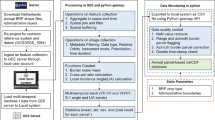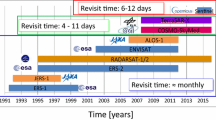Abstract
In this paper, the use of synthetic aperture radar (SAR) for the monitoring of land consumption is analyzed. The paper presents an automatic procedure that integrates SAR and optical data, which can be effectively used to generate land consumption maps or update existing maps. The main input of the procedure is a series of SAR amplitude images acquired over a given geographical area and observation period. The main assumption of the procedure is that land consumption is associated with an increase of the SAR amplitude values. Such an increase is detected in the SAR amplitude time series using an automatic Bayesian algorithm. The results based on the SAR amplitude are then filtered using an NDVI map derived from optical imagery. The effectiveness of the proposed procedure is illustrated using SAR data from the Sentinel-1 and TerraSAR-X sensors, and optical data from the Sentinel-2 sensor.


























Similar content being viewed by others
Notes
The number of images to create an accurate NDVI map depends mainly on the season (vegetation phenology) and on the cloud cover. Theoretically, even one image could be enough if acquired in the season of maximum vegetation growth and with no cloud cover.
The Google Earth Engine includes historical images from 1990 to date, continuously collects new images and, in addition to providing APIs (application programming interfaces) in Java Script and Python, provides useful tools for analyzing large sets of images.
This value was chosen considering the resolution of Sentinel-2. Lower values would have been too restrictive in identifying areas where the pixel is mixed (for example, building site areas with little grass).
References
Angelis, C. F., Freitas, C. C., Valeriano, D. M., & Dutra, L. V. (2002). Multitemporal analysis of land use/land cover JERS-1 backscatter in the Brazilian tropical rainforest. International Journal of Remote Sensing, 23(7), 1231–1240.
As-syakur, A. R., Wayan Sandi Adnyana, I., Wayan Arthana, I., & Wayan Nuarsa, I. (2012). Enhanced built-up and bareness index (EBBI) for mapping built-up and bare land in an urban area. Remote Sensing, 4, 2957–2970.
Brook R. M. and D ávila J. (2000). The peri-urban interface: a tale of two cities. Gwynedd, Wales: School of Agricultural and Forest Sciences, University of Wales and Development Planning.
Campbell J.B., Wynne R.H. (2011). Introduction to remote sensing. Guilford Press, 667pp.
Cardona, O.D., M.K. van Aalst, J. Birkmann, M. Fordham, G. McGregor, R. Perez, R.S. Pulwarty, E.L.F. Schipper, and B.T. Sinh (2012). Determinants of risk: exposure and vulnerability. In: Managing the risks of extreme events and disasters to advance climate change adaptation [Field, C.B., V. Barros, T.F. Stocker, D. Qin, D.J. Dokken, K.L. Ebi, M.D. Mastrandrea, K.J. Mach, G.-K. Plattner, S.K. Allen, M. Tignor, and P.M. Midgley (eds.)]. A Special Report of Working Groups I and II of the Intergovernmental Panel on Climate Change (IPCC). Cambridge University Press, Cambridge, UK, and New York, NY, USA, pp. 65–108.
Congedo L., Marinosci I., Riitano N., Strollo A., De Fioravante P., Munafò M. (2017). Monitoring of land consumption: an analysis of loss of natural and agricultural areas in Italy. Annali di Botanica, 7: 1–9.
CRCS. (2012). Rapporto 2012. Centro di Ricerca sui Consumi di Suolo. Milano: INU Edizioni.
EEA, European Environment Agency (2011). Urban soil sealing in Europe. https://www.eea.europa.eu/articles/urban-soil-sealing-in-europe.
Estoquea, R. C., Murayamaa, Y., & Akiyamab, C. M. (2015). Pixel-based and object-based classifications using high- and medium-spatial-resolution imageries in the urban and suburban landscapes. Geocarto International, 30(10), 1113–1129.
European Commission (2011). Our life insurance, our natural capital: an EU biodiversity strategy to 2020. COM (2011) 244 final. Brussels.
European Commission (2011b). Roadmap to a resource efficient Europe. COM (2011)571 final. Brussels.
European Commission (2012). Guidelines on best practice to limit, mitigate or compensate soil sealing. SWD (2012) 101. Brussels.
Fan, F., Weng, Q., & Wang, Y. (2007). Land use and land cover change in Guangzhou, China, from 1998 to 2003, based on Landsat TM/ETM+ imagery. Sensors, 7, 1323–1342.
Gómez, C., White, J., & Wulder, M. (2016). Optical remotely sensed time series data for land cover classification: a review. ISPR Journal of Photogrammetry and Remote Sensing, 116(June 2016), 55–72.
Gomez-Chova, L., Fernández-Prieto, D., Calpe, J., Soria, E., Vila, J., & Camps-Valls, G. (2006). Urban monitoring using multi-temporal SAR and multi-spectral data. Pattern Recognition Letters, 27(4), 234–243.
Gorelick, N., Hancher, M., Dixon, M., Ilyushchenko, S., Thau, D., & Moore, R. (2017). Google Earth Engine: planetary-scale geospatial analysis for everyone. Remote Sensing of Environment, 202, 18–27.
Huber S., Prokop G., Arrouays D., Banko G. et al. (2008). Environmental assessment of soil for monitoring. Volume I indicators and criteria. JRC, Office for the Official Publications of the European Communities.
Irwin, E. G., & Bockstael, N. E. (2004). Land use externalities, open space preservation, and urban sprawl. Regional Science and Urban Economics, 34(6), 705–725.
ISPRA, Istituto Superiore per la Protezione e Ricerca Ambientale (2017). Consumo di suolo, dinamiche territoriali e servizi ecosistemici. Edizione 2017. (In Italian).
Lam N. SN. (2008). Methodologies for mapping land cover/land use and its change. Advances in land remote sensing. Springer, pp 341–367.
Lindblad T., Kinser J.M. (2005). Image processing using pulse-coupled neural networks, Second, Revised Version, 169pp.
Maes, J., Egoha, B., Willemen, L., et al. (2012). Mapping ecosystem services for policy support and decision making in the European Union. Ecosystem Services, 1, 31–39.
Moran, M. S., Hymer, D. C., Qi, J., & Kerr, Y. (2002). Comparison of ERS-2 SAR and Landsat TM imagery for monitoring agricultural crop and soil conditions. Remote Sensing of Environment, 79(2), 243–252.
Munafò M., Riitano N. (2016). Cause ed effetti del consumo di suolo. Consumo di suolo, dinamiche territoriali e servizi ecosistemici. Ed. 2016, pp. 4–6 (in Italian).
Munafò M., Marinosci I., Congedo L., La Mantia C., Luti T., Marchetti M., Raudner A., Riitano N., Sallustio L., Strollo A. (2016). Monitoraggio del territorio e del consumo di suolo in Italia. Consumo di suolo, dinamiche territoriali e servizi ecosistemici. Ed. 2016, pp. 23–26 (in Italian).
O’Ruanaidh J.J.K., Fitzgerald W.J. (1996). Numerical Bayesian methods applied to signal processing. Springer, 244pp.
Patel, N., Angiuli, E., Gamba, P., Gaughan, A., Stevens, F., Tatem, A., & Trianni, G. (2015). Multitemporal settlement and population mapping from Landsat using Google Earth Engine. International Journal of Applied Earth Observation and Geoinformation, 35(Part B), 199–208.
Poursanidis, D., & Chrysoulakis, N. (2017). Remote sensing, natural hazards and the contribution of ESA Sentinels missions. Remote Sensing Applications: Society and Environment, Volume, 6(April 2017), 25–38.
Satalino G., Balenzano M.F., Belmonte A. and Impedovo D. (2011). Land cover classification by using multi-temporal COSMO-SkyMed data. 2011 6th International Workshop on the Analysis of Multi-temporal Remote Sensing Images (Multi-Temp).
Scalenghe R., Ajmone Marsan F. (2009). The anthropogenic sealing of soil in urban areas. Landscape and urban planning, Volume 90, Issues 1-2, 15 March 2009, Pages 1–10.
Sun, Z., Wang, C., Guo, H., & Shang, R. (2017). A modified normalized difference impervious surface index (MNDISI) for automatic urban mapping from Landsat imagery. Remote Sensing, 9, 942.
United Nations (2014). World urbanization prospects, the 2014 revision. Final report, ST/ESA/SER.A/366, New York.
United Nations (2015). Transforming our world: the 2030 agenda for sustainable development. A/RES/70/1, UN General Assembly, 21 October, 2015.
Yousif O., Ban Y. (2015). Object-based urban change detection using high resolution SAR images. 2015 Joint Urban Remote Sensing Event (JURSE).
Zhang X., Tang X., Gao X., Zhao H. (2018). Multitemporal soil moisture retrieval over bare agricultural areas by means of alpha model with multisensor SAR data. Advances in Meteorology, Volume 2018, Article ID 7914581, 17 pages.
Zhu, Z., Woodcock, C. E., Rogan, J., & Kellndorfer, J. (2012). Assessment of spectral, polarimetric, temporal, and spatial dimensions for urban and peri-urban land cover classification using Landsat and SAR data. Remote Sensing of Environment, 117, 72–82.
Author information
Authors and Affiliations
Corresponding author
Ethics declarations
Conflict of interest
The authors declare that they have no conflict of interest.
Rights and permissions
About this article
Cite this article
Mastrorosa, S., Crosetto, M., Congedo, L. et al. Land consumption monitoring: an innovative method integrating SAR and optical data. Environ Monit Assess 190, 588 (2018). https://doi.org/10.1007/s10661-018-6921-y
Received:
Accepted:
Published:
DOI: https://doi.org/10.1007/s10661-018-6921-y




